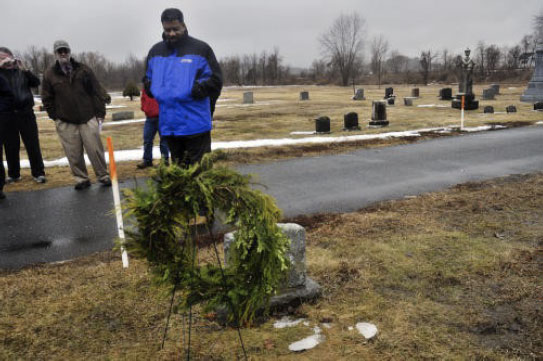Du Bois great-grandson McFarlane tours Great Barrington landmarks

Arthur E. McFarlane II lays a wreath on the grave of his great-grandmother, Nina Gomer Du Bois,
first wife of W.E.B. Du Bois, on Wednesday in Great Barrington. McFarlane’s first trip to the town was packed with activities and a ‘historic’ presentation at the Du Bois Center. (Caroline Bonnivier Snyder / Berkshire Eagle Staff)
GREAT BARRINGTON—There are a lot of pieces to the puzzle that is Arthur E. McFarlane II’s family tree. One of those pieces, his great-grandfather, W.E.B. Du Bois, is the kind of puzzle piece that completes several different pictures.
Du Bois lived in Great Barrington for most of his 95 years. In 1909, he co-founded the National Negro League, later renamed the National Association for the Advancement of Colored People (NAACP), founded the study of sociology, was a proponent of the Harlem Renaissance in the 1920s, and wrote several books that had a major impact on the civil rights movement.
About as many biographies have been written about Du Bois and his legacy. He died 50 years ago this year while in Ghana.
And on a rain-soaked Wednesday in the Berkshires, McFarlane made his first trip to Great Barrington to see where his revered great-grandfather once lived. It was a day packed with activities, including sight-seeing, paying his respects to his family’s plot and closed out with a “historic,” packed presentation.
“It’s really interesting seeing all the pieces of that puzzle come together in my mind,” McFarlane said. “W.E.B. Du Bois casts a large shadow in a lot of ways. He really is the father of modern civil rights.”
McFarlane, a resident of Aurora, Colo., “jumped right into a tour” of all the places Du Bois once lived, he said. He also visited the Searles Castle and several of his family’s gravestones, laying a wreath at his family’s plot at Mahaiwe Cemetery.
Du Bois’ legacy has remained intact through the several now-historic sites, and for the last seven years, the Du Bois Center has hosted numerous events aimed at educating the community with artifacts, a bookstore, library and museum.
The Du Bois Center sponsored the last event of McFarlane’s night, a presentation called “Du Bois at 50: A Hometown Retrospective.” It was this first of several events that will take place throughout the year that are sponsored by the Du Bois Center.
More than 70 people attended the retrospective, held at the First Congressional Church on Main Street. Author Scott Christianson emceed. He read the commonwealth proclamation since state Rep. William “Smitty” Pignatelli, could not make the event as planned.
Students ranging from elementary school to college read reflections of Du Bois. McFarlane received a recognition from the Mahaiwe Cemetery. He fumbled The Du Bois Center Pioneer Award that Massachusetts College of Liberal Arts professor Frances Jones-Sneed gave him, but caught it before it crashed it to the ground. The audience applauded McFarlane’s quick hands. He said it comes from volleyball.
Great Barrington students, their teachers, all ages and races and Great Barrington Select Board members made up the presentation’s audience. A reception was held at the Du Bois Center afterward.
“I thought it was history-making,” said Randy Weinstein, the executive director of the Du Bois Center. “It was beyond my wildest dreams.”
In a slide-show presentation, McFarlane showed several old pictures from his family, some featuring him when he was but a child. He was born in 1957, six years before Du Bois died, but doesn’t have a lot of memories of his great-grandfather outside of the family photos.
McFarlane’s presentation reaffirmed most of what Lee resident Diana Wellington already had read, but she was also intrigued to hear about Du Bois’ connection to the artists of the Harlem Renaissance era, and to hear McFarlane’s story as well.
“I’m so pleased that his great-grandson gave us an insight into growing up with a famous grandpa that was so important to the history of not only this area, but really, our country and throughout the world,” Wellington said.
One thing McFarlane catches himself doing is playing the mental “what-if” game, wondering where the civil rights would have been without his great-grandfather, he said.
“But,” McFarlane said, “It’s hard to tell without his motivating force, without his intellectual force, what things would have been done. You could always pull one or two people out of a puzzle, and it still comes out to be about the same thing it was before.”

